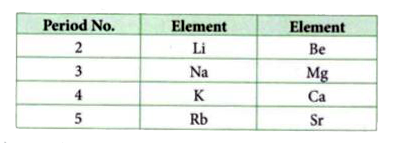Write the electronic configurations of the elements : Chlorine and Phosphorus.
To write the electronic configurations of chlorine and phosphorus, we will follow these steps:
Step 1: Identify the Atomic Numbers
- Chlorine (Cl) has an atomic number of 17.
- Phosphorus (P) has an atomic number of 15.
Step 2: Understand the Electron Configuration
The electron configuration describes the distribution of electrons in an atom's orbitals. The order of filling the orbitals is based on the Aufbau principle, which states that electrons occupy the lowest energy orbitals first. The order of filling is generally:
1s, 2s, 2p, 3s, 3p, 4s, 3d, 4p, etc.
Step 3: Write the Electron Configuration for Chlorine
1. Start filling the orbitals with electrons:
- 1s: 2 electrons → 1s²
- 2s: 2 electrons → 2s²
- 2p: 6 electrons → 2p⁶
- 3s: 2 electrons → 3s²
- 3p: 5 electrons → 3p⁵
2. Combine these to get the full configuration for chlorine:
- Chlorine (Cl): 1s² 2s² 2p⁶ 3s² 3p⁵
Step 4: Write the Electron Configuration for Phosphorus
1. Start filling the orbitals with electrons:
- 1s: 2 electrons → 1s²
- 2s: 2 electrons → 2s²
- 2p: 6 electrons → 2p⁶
- 3s: 2 electrons → 3s²
- 3p: 3 electrons → 3p³
2. Combine these to get the full configuration for phosphorus:
- Phosphorus (P): 1s² 2s² 2p⁶ 3s² 3p³
Final Answer
- Chlorine (Cl): 1s² 2s² 2p⁶ 3s² 3p⁵
- Phosphorus (P): 1s² 2s² 2p⁶ 3s² 3p³
---
- Chlorine (Cl) has an atomic number of 17.
- Phosphorus (P) has an atomic number of 15.
The electron configuration describes the distribution of electrons in an atom's orbitals. The order of filling the orbitals is based on the Aufbau principle, which states that electrons occupy the lowest energy orbitals first. The order of filling is generally:
1s, 2s, 2p, 3s, 3p, 4s, 3d, 4p, etc.
1. Start filling the orbitals with electrons:
- 1s: 2 electrons → 1s²
- 2s: 2 electrons → 2s²
- 2p: 6 electrons → 2p⁶
- 3s: 2 electrons → 3s²
- 3p: 5 electrons → 3p⁵
2. Combine these to get the full configuration for chlorine:
- Chlorine (Cl): 1s² 2s² 2p⁶ 3s² 3p⁵
1. Start filling the orbitals with electrons:
- 1s: 2 electrons → 1s²
- 2s: 2 electrons → 2s²
- 2p: 6 electrons → 2p⁶
- 3s: 2 electrons → 3s²
- 3p: 3 electrons → 3p³
2. Combine these to get the full configuration for phosphorus:
- Phosphorus (P): 1s² 2s² 2p⁶ 3s² 3p³
- Chlorine (Cl): 1s² 2s² 2p⁶ 3s² 3p⁵
- Phosphorus (P): 1s² 2s² 2p⁶ 3s² 3p³
Topper's Solved these Questions
- STRUCTURE OF ATOMBOOK - PRADEEPCHAPTER - STRUCTURE OF ATOMEXERCISE - Advanced Problems For Competitions
18 Videos
- STRUCTURE OF ATOMBOOK - PRADEEPCHAPTER - STRUCTURE OF ATOMEXERCISE - Test Your Grip (Multiple Choice Questions)
30 Videos
- STRUCTURE OF ATOMBOOK - PRADEEPCHAPTER - STRUCTURE OF ATOMEXERCISE - Curiosity Question
6 Videos
- STATES OF MATTER: SOLID MATTERBOOK - PRADEEPCHAPTER - STATES OF MATTER: SOLID MATTEREXERCISE - COMPETITION FOCUS (ASSERTION-REASON)
17 Videos
- THERMODYNAMICSBOOK - PRADEEPCHAPTER - THERMODYNAMICSEXERCISE - MULTIPLE CHOICE QUESTION ( BASED ON PRACTICAL CHEMISTRY)
3 Videos
Similar Questions
Knowledge Check

Write electronic configuration of element E.A2,8,3B2,8,6C2,8,5D2,8
Write the electronic configuration of potassium
View SolutionWriting Electronic Configurations
View SolutionWrite the electronic configuration of the element having atomic number 56
View SolutionElectronic Configuration Of Elements
View SolutionWrite the electronic configuration of the element with atomic number 102.
View SolutionWrite the electronic configuration of the element with atomic number 102.
View SolutionWhich is the last element in the series of the actinods? Write the electronic configuration of this element. Comment on the possible oxidation state of this element.
View Solution

